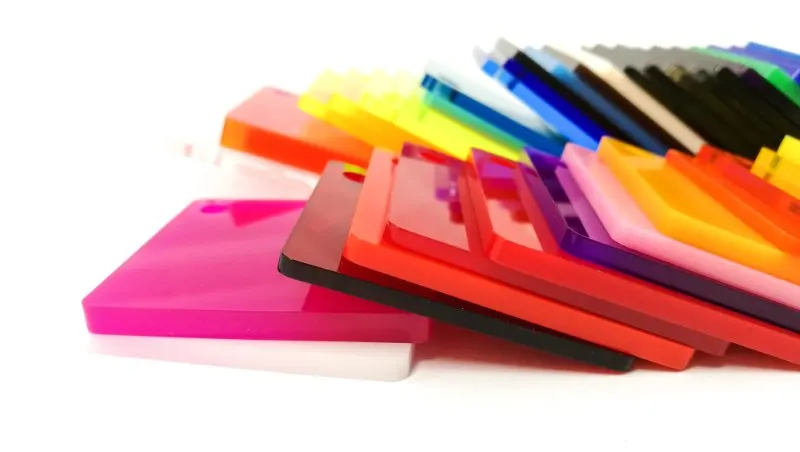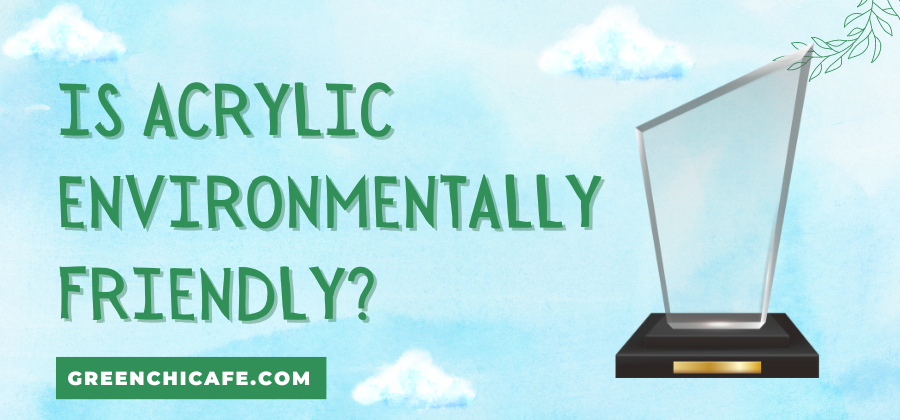Last Updated on June 3, 2024 by Annie Baldwin
Acrylic plastic has become ubiquitous in our lives — from plexiglass to insulation to fabrics.
But is this versatile, transparent material actually sustainable and eco-friendly?
Let’s delve into acrylic’s environmental impact and recyclability.
Is Acrylic Environmentally Friendly?

No, acrylic is generally not considered an environmentally friendly material.
Acrylic comes in many forms, from paints to yarns.
Acrylic is a type of plastic that does not biodegrade easily, is difficult to recycle, and produces toxic fumes during manufacturing.
Most acrylic ends up in landfills.
Key Points
- Acrylic is a form of plastic and plastics are not biodegradable
- Acrylic production releases toxic fumes and chemicals
- Acrylic is difficult to recycle and mostly ends up in landfills
Our Opinion
Based on the research, our experts believe acrylic should not be considered an eco-friendly or sustainable material.
While acrylic can be recycled, the process is difficult and most acrylic still ends up in landfills.
We think more sustainable alternatives to acrylic should be explored.
Is Acrylic Plastic Sustainable?

The short answer is no. Acrylic is not considered a sustainable or eco-friendly material for several reasons:
- Acrylic is a petroleum-based plastic that requires substantial chemicals and energy to produce. The manufacturing process releases toxic fumes and greenhouse gases.
- Most acrylic ends up in landfills because it does not biodegrade easily. Acrylic can take hundreds of years to decompose.
- While technically recyclable, acrylic is difficult to recycle because of its high molecular weight. Most recycling centers do not accept acrylic products.
- Acrylic fibers shed microscopic plastic bits into waterways when washed. These acrylic microplastics accumulate in the environment.
The durability and wearability that make acrylic so useful also contribute to its unsustainability. Acrylic’s longevity means it persists in landfills and the environment.
Some acrylic manufacturers are exploring “green” production methods using fewer toxic chemicals. But most acrylic is still petroleum-based virgin plastic. The sheer volume of acrylic produced makes it unlikely to become truly eco-friendly any time soon.
Can You Recycle Acrylic?
While technically recyclable, acrylic is rarely accepted by municipal recycling programs. Here’s why acrylic recycling is so challenging:
- Acrylic’s high molecular weight makes it difficult to reprocess into new plastic products compared to lower-weight plastics like PET.
- There is low market demand for recycled acrylic. Manufacturers prefer to use virgin acrylic resin.
- Acrylic recycling requires specialized equipment to grind and reform the plastic.
- Acrylic products often contain other materials like fabric, foam, or metal that hinder recycling.
- Clear acrylic plastic is hard for recycling sorting machines to detect.
Some acrylic manufacturers like Lucite International have invested in recycling programs. But overall, acrylic recycling rates remain very low compared to PET or HDPE plastics. Most acrylic ends up in landfills.
So in practice, recycling options for acrylic are limited. While technically recyclable, acrylic is rarely accepted by curbside programs. The best option is to avoid acrylic products when more eco-friendly alternatives exist.
What Is Acrylic’s Carbon Footprint?

Acrylic has a sizable carbon footprint due to its petroleum-based production process. Here’s a closer look at the environmental impact:
- Acrylic is derived from propylene, a petroleum byproduct. Extracting and refining oil for propylene emits greenhouse gases.
- The acrylic polymerization process requires substantial energy input, often from fossil fuels that generate emissions.
- Some acrylic production involves toxic solvents like acetone that require energy-intensive distillation. This increases emissions.
- Transporting raw materials and finished acrylic products over long distances burns fossil fuels.
Comprehensive life cycle assessments consistently show acrylic’s carbon footprint is larger than eco-friendly alternatives like cellulose acetate derived from renewable wood pulp. While acrylic can be useful for some applications, it comes at a high emissions cost.
Brands seeking to reduce the carbon footprint of their products should consider avoiding petroleum-based acrylic in favor of lower-impact options. With growing consumer demand for sustainability, an eco-friendly materials strategy is key.
How Is Acrylic Produced?
The production of acrylic involves multiple steps to create the synthetic polymer material from petroleum-derived chemicals.
- Propylene, extracted from crude oil, is combined with oxygen to produce acrylic acid.
- The acrylic acid is purified and polymerized with a catalyst to begin forming polymer chains.
- Additional processing controls the polymerization to achieve desired physical properties like clarity, weatherability, and impact resistance.
- The acrylic polymer is then pelletized for easy transport to manufacturers.
- Manufacturers melt the pellets and mold or extrude the acrylic into sheets, fibers, or other useful forms.
Compared to materials derived from renewable resources, acrylic production consumes significant amounts of energy and relies heavily on the petrochemical industry. While acrylic’s transparency and weather resistance make it uniquely suited for some applications, the complex petroleum-based process has a sizable carbon footprint.
For brands and consumers looking to reduce environmental impact, choosing eco-friendly alternatives is an important strategy whenever acrylic properties are not strictly required.
Does Acrylic Biodegrade?
Unlike natural materials such as cotton or wood, acrylic does not biodegrade. The strong carbon-carbon bonds that give acrylic its durability and longevity prevent the material from being broken down by microorganisms.
When acrylic products reach the end of their usable life, they persist in landfills and the environment. The estimated time for total biodegradation of acrylic is hundreds of years.
Recycling acrylic can help reduce waste, but recycling rates remain low. Acrylic’s lack of biodegradability means responsible disposal is critical to avoiding long-term pollution and microplastic contamination.
For many applications, biodegradable materials like paper, cardboard, wood, bamboo, or organic textiles can provide an eco-friendly alternative. Brands and consumers seeking to reduce plastic waste should consider if an acrylic product’s benefits outweigh its enduring environmental impact.
Choosing sustainable materials is an important step towards reducing petroleum consumption and plastic pollution. When acrylic’s unique properties are needed, recycling and proper disposal are essential to ensure this non-biodegrading plastic does not end up contaminating ecosystems for centuries.
FAQ
Is Acrylic More Sustainable Than Plastic?
No, acrylic is a type of plastic so it is not more sustainable than plastic in general. Both acrylic and many other plastics are derived from petroleum.
Is Acrylic a Biodegradable Material?
No, acrylic is not a biodegradable material. It takes hundreds of years to break down in landfills.
Is Glass or Acrylic Better for the Environment?
Glass is generally considered more eco-friendly than acrylic. Glass is recyclable, while acrylic is difficult to recycle. Glass also does not release toxic fumes when produced.
What Are the Environmental Issues With Acrylic?
Acrylic is not biodegradable, produces toxic fumes when manufactured, and is difficult to recycle. Most acrylic ends up in landfills.
Conclusion
Acrylic is not considered an environmentally friendly material. Acrylic is a form of plastic that does not biodegrade easily and is difficult to recycle. Most acrylic ends up in landfills at the end of its lifespan. The production of acrylic also releases harmful toxins. Therefore, acrylic cannot be considered a sustainable or eco-friendly material.
